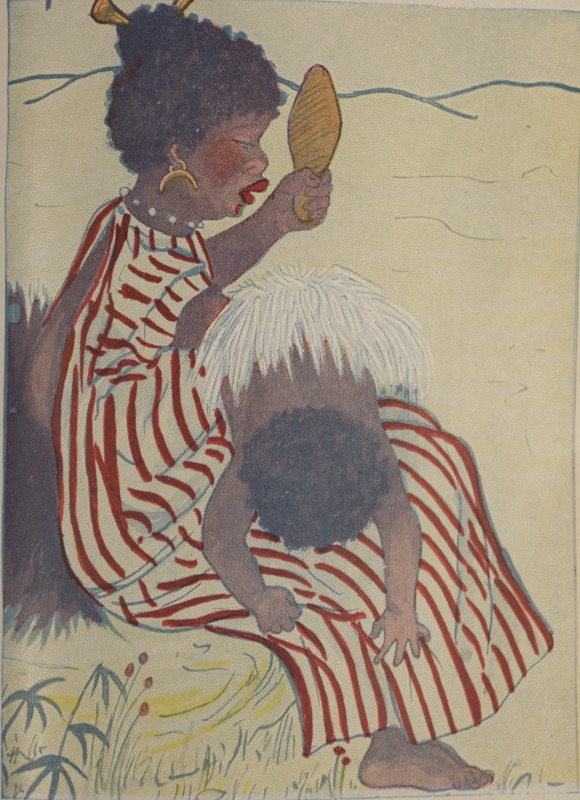In this 1926 version of Helen Bannerman’s Little Black Sambo, Sambo and his mother, Mumbo, differ aesthetically from the more abundant racist tropes of pickaninny and mammy. Sambo and Mumbo each have distinct tribal dress, pointing to the visual representations of Africa in the American imagination at the time of its publishing. Colonialism and the Europe’s characterization of Africa as the Dark Continent lie at the center of this illustration’s influence. While the image may not immediately prompt connections with racist depictions of African Americans, it does attempt to present African dress and culture through a Western lens. The image is discomfiting in both its attempt to depict African culture and the hybridity of a colonized representation of Africa. This illustration uses both western influences and stereotypes of Africa to create an image that is at once accessible for the white, western reader and yet still exotic.
Colonialism has framed Africa as the Dark Continent, a historical process that directly influences the imagery of this version of Little Black Sambo. In her article analyzing the root of western representation of Africa, Lucy Jarosz states, “Africa as the Dark Continent is portrayed as primeval, bestial, reptilian, or female entity to be tamed, enlightened, guided, opened, and pierced by white, European males through Western science, Christianity, commerce and colonization” (108). The sentiment of an exotic “other” that is intriguingly different yet able to be tamed shines through in this image. The bones in Mumbo’s hair and ears, the open back to her dress, and the necklace she wears that appears to be piercing her skin characterize her as stereotypically tribal and African. Similarly, Sambo wears only a grass skirt and nothing else, another marker of the primitiveness of African culture in the American imagination. The backdrop to the image further others Sambo and Mumbo as it depicts an exotic location, most likely intended by the illustrator to be Africa. The illustration’s problematic framework lies not only in the colonial representation of Africa, but also in the strange hybrid between colonized and western imagery.
The illustration characterizes Sambo and Mumbo as African exotics while also adhering to western standards. The act of spanking Sambo is a reflection of western modes of disciplining children and a nod to American forms of child rearing. At the same time, Mumbo holds a paddle in her hand that is the same color as the bones in her hair and ear, a tribal twist on spanking. Even the jewels around her neck mirror pearls, a sign of western influence distinctly out of place in “tribal” Africa. Additionally, Mumbo’s bright red lips imply she is wearing lipstick, and the red shading on her face mirrors blush. The markers of western beauty standards at the time of the book’s publishing influence the hybridity of the colonized image.
Jarosz, Lucy. Constructing the Dark Continent: Metaphor as Geographic Representation of Africa. Geografiska Annaler. Series B, Human Geography, Vol. 74, No. 2 (1992), pp. 105-115
